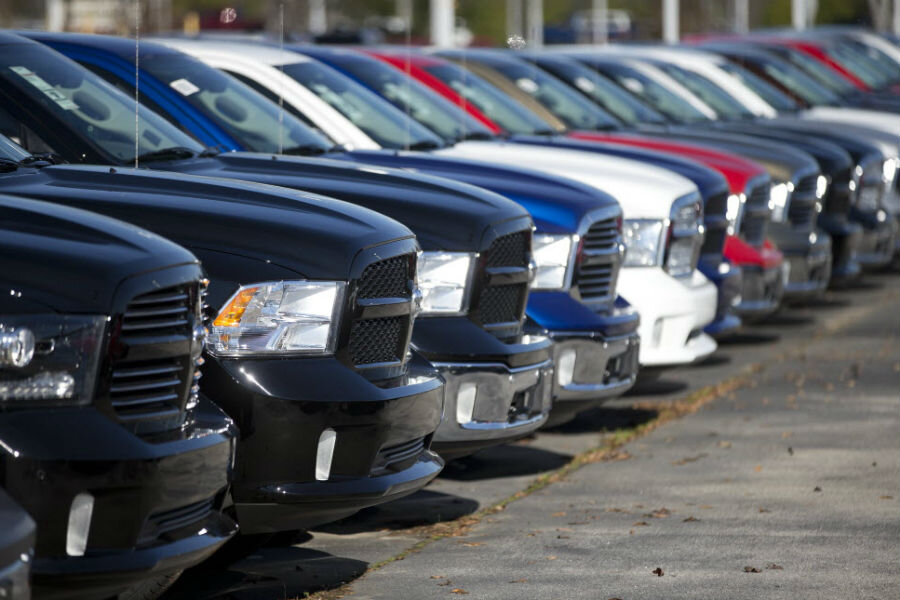Car sales jump: Consumer revival in 2014 wasn't just about falling gas prices
Loading...
| Washington
Automakers finished out a banner year in December, with sales gains that symbolize not just an industry’s strength but also a revival for the US consumer.
American households finally were ready to make upgrades of the four-wheeled variety in volumes not seen since before the deep recession that began in 2007.
Car purchases revved up as 2014 went on – starting at a pace barely above 15 million units (annualized) and ending the year not far from 17 million.
Falling gas prices certainly helped, but the good year for carmakers also reflects low interest rates, reviving consumer confidence, and pent-up demand. Many Americans have been waiting to replace the vehicles they rely on for everything from commuting to taking road trips to transporting kids and groceries.
“Many factors have helped car sales,” industry analyst Jessica Caldwell said in a forecast emailed prior to the automakers’ Monday release of 2014 sales totals. “Low gas prices, a record stock market and the improving economy are making people feel more financially comfortable.”
Ms. Caldwell, of the car-shopping website Edmunds.com, said gas prices have played a role not just in the number of cars sold but also in the type. The prospect of falling fuel costs buoyed demand for pickup trucks and small “crossover” sport-utility vehicles, she said.
General Motors, Ford, and Toyota are now the top three sellers in the US market, each delivering more than 200,000 vehicles for sale in December alone. They’re followed by Fiat Chrysler, Honda, Nissan, and Hyundai/Kia.
Toyota’s sales were up 6.2 percent in 2014 from the year before, and GM was up 5.3 percent. Some of the smaller carmakers posted even stronger gains, with Subaru up 21 percent, Chrysler up 16 percent, and Nissan up 11 percent.
Honda’s sales rose only 1 percent for the year, Ford’s volume actually fell a bit, according to numbers reported by the companies and tracked by WardsAuto.
The industry finished the year with sales volume running at 16.8 million units (annualized rate) in December, WardsAuto reported. That’s a pace typical of pre-recession years like 2005.
The industry’s recovery has paralleled the slowly reviving health of US consumers over the past five years.
Car sales plunged during the 2008 financial crisis to lows not seen since a deep recession in the early 1980s.
Purchases of durable goods like cars typically suffer the most in a recession, since families postpone those in favor of necessities like food and rent.
Federal Reserve policy has helped to keep interest rates low – to fuel demand for things like houses and cars, since 2008. But it took time for households to repair their finances, so that they are readier to take on new debt once again if they choose.
Another important factor has been a strengthening job market and a related rise in consumer confidence. Optimism about the economy is hardly robust, but it rose significantly in 2014 as the nation’s official unemployment rate fell almost a percentage point.
Gains in the stock market, which affect upper-income households especially, may have boosted sales of high-end cars. Toyota predicts next year could be the best ever for its Lexus brand, after a record month in December.
For carmakers, the rising sales have been a bright spot in the midst of a damaging spate of product recalls. To some extent, though, the recall news can be viewed as positive trend of attention flowing to the important issue of vehicle safety.
The rebound in sales also caps a five-year recovery for an industry that was hit so hard by the recession that two key players (GM and Chrysler) relied on government-assisted restructuring in bankruptcy to stay afloat.
Presidents Bush and Obama both supported the bailout policies. "Inaction could have cost the broader economy more than one million jobs," Treasury Secretary Jacob Lew said when the Treasury sold the last of the GM stock shares related to the bailouts, some 13 months ago.
Just last month, the Treasury sold the last of its holdings related to the auto bailout – shares in the car-loan provider Ally Financial, formerly known as GMAC, Inc. In the end the auto-related aid programs cost US taxpayers an estimated $9.3 billion, the Treasury said.






